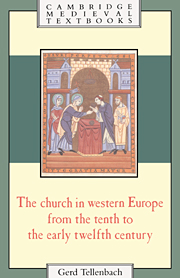Book contents
- Frontmatter
- Contents
- Translator's note
- Author's preface
- List of abbreviations
- 1 Western Christendom and its environment in the tenth and eleventh centuries
- 2 The church and its manifestations on earth
- 3 The material existence of the churches and the clergy
- 4 Religious life and thought
- 5 The beginnings of the revolution in church history
- 6 Gregory VII (1073–1085)
- 7 Continuing conflicts between established principles
- 8 Pope, church, and Christendom
- Epilogue
- Select bibliography
- Index
- Cambridge Medieval Textbooks
7 - Continuing conflicts between established principles
Published online by Cambridge University Press: 05 June 2012
- Frontmatter
- Contents
- Translator's note
- Author's preface
- List of abbreviations
- 1 Western Christendom and its environment in the tenth and eleventh centuries
- 2 The church and its manifestations on earth
- 3 The material existence of the churches and the clergy
- 4 Religious life and thought
- 5 The beginnings of the revolution in church history
- 6 Gregory VII (1073–1085)
- 7 Continuing conflicts between established principles
- 8 Pope, church, and Christendom
- Epilogue
- Select bibliography
- Index
- Cambridge Medieval Textbooks
Summary
Gregory VII had left the Roman church and the papacy in a state of deep confusion; the various national churches were in a state of either opposition or sceptical neutrality. True, the antipope was able to establish himself only in parts of Germany and Italy, and could not maintain his position in Rome; but it took a whole year before the Gregorians managed to elect a new pope. Victor III (1086–7), previously Abbot Desiderius of Monte Cassino, never succeeded in pacifying Rome, and was so fiercely attacked by the radical supporters of Gregory VII for his previous attempts at mediation between the parties, in particular by Richard of Saint-Victor in Marseilles and by Hugo of Lyons, that he, the peacemaking pope, was finally forced to excommunicate them. On his death in September 1087 there was again a delay of half a year until the election of Urban II, which could be held only outside Rome, in Terracina. Even after this it was many years before Gregory's successor could gain the upper hand over his opponents.
THE SCHISM AND ITS CONSEQUENCES
The election of Odo of Ostia as Pope Urban II in Terracina by the majority of the cardinal bishops together with representatives of the cardinal priests and cardinal deacons led to a gradual recovery in the fortunes of those groups within the church who wished to continue Gregory's policies and oppose Henry IV and Clement III.
- Type
- Chapter
- Information
- Publisher: Cambridge University PressPrint publication year: 1993



